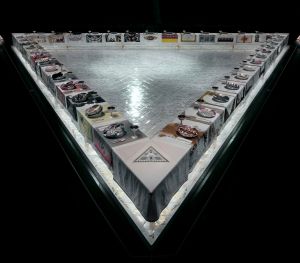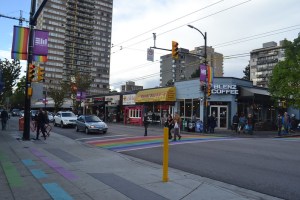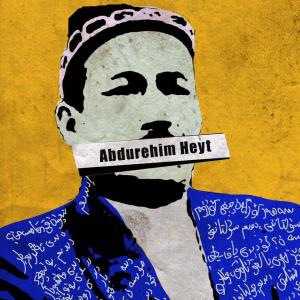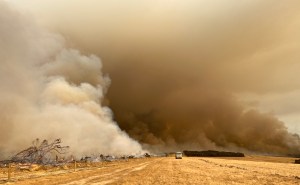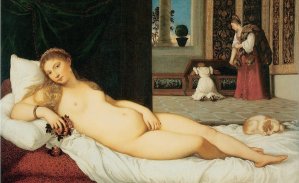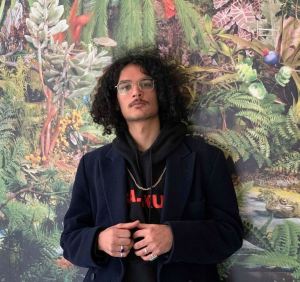Eva Narae leading BAHAY’s music committee. Photo by Ben J.
Sunday, August 11. Over twenty Montreal Asian artists performed at Riverside St-Henri to raise awareness for disaster relief projects in the Philippines.
Brought to us by BAHAY (meaning “home” in Tagalog), a non-profit organization known for combining the promotion of Asian representation and the support for disaster relief efforts worldwide, and MTLBLISS, a local artist collective with a multicultural vision, the event created a powerful dialogue between the Asian communities in Canada and the plight faced by those in the Asian homelands.
Montreal: a Land of Exile?
The performance featured a line-up of artists of Asian heritage: musicians Hua Li, Waterboii, m0llygum, Lil Lonely, Netherboii, Narae, 7onestarr, Jezebel, DREA, JIN, DJ coolchels, and Trannn; visual artists spiltmilk, Peniel Hong, Pomelo (alias), and OHHAEIN. The party generated a different beat for Montreal, a predominantly white, Francophone, and historically Roman Catholic cultural enclave, where the opportunities of being recognized and shown onstage are oftentimes a privilege for some.
“The Asian music scene in Montreal is still in its development,” says JIN, one of the performers and emerging artists in the Hip-Hop/R&B scene. “[There has been a] recent boom in streaming services and the accessibility to the tools to make music. [But] compared to the other big cities in Canada like Toronto or Vancouver, our artists are still very much underexposed.”
Currently, JIN is working on their next project exploring Korean R&B, a scene that is gaining momentum both in Montreal and worldwide. Planning to release a bilingual (Korean and English) song, “Go Away”, this October, JIN thinks of BAHAY’s concept as refreshing, and anticipates similar platforms in the future to bring Asian diaspora musicians even closer together.
“I know they hate cause they can’t believe what they seeing.”
For BAHAY, to rediscover the Asian Canadian talents is also to shatter the old stereotypes prevalently associated with Asians in the West. Their collab with the artist collective BLISS uncannily juxtaposed the practice of free-spirited music with “Asianness,” as if calling out the public for wearing racial biases in the back of their minds.
“I think people doubt me (as a rapper) a lot,” says Chuong, BAHAY’s co-founder of Vietnamese heritage, performing under the artist name Waterboii. “I remember people approaching me really differently when I do production or photography work for them (as a producer or photographer), vs. when they look at me as a performer and rapper.”
In the album version of the song “Blue Eyes White Dragon” (which was largely revised from the version currently online), Waterboii rapped using the Japanese manga Yu-Gi-Oh card reference. As the “white” in “white dragon” is a euphemism for cocaine and that adrenaline rush, the song authentically captures the most obnoxious self, which — in the case of fighting the Asian stereotypes in Montreal — is simply about being upfront about how tired one is by being doubted for being Asian.
The Yu-Gi-Oh aesthetic of the day.
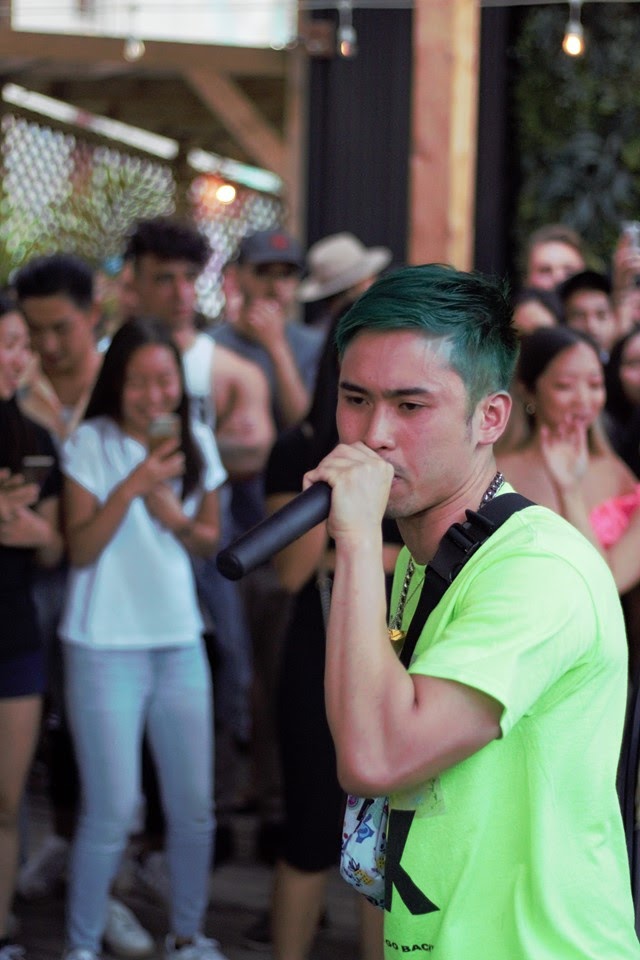
Waterboii performing.
“I know they hate cause they cant believe what they seeing,” Waterboii talks about how naysayers are often dismissing their own talent due to racial biases in another song, “Woah.”
Waterboii’s endeavor resonated with the crowd, as it destabilized, among many other things, the prevailing discourse of “model minority,” which asserts the Asian Canadians as always abiding with hard work, family values, and strict parental upbringing in order to overcome racial discrimination.
“[I]n family, there’s this idea of setting aside our differences.”
But does each Asian diaspora group get the same degree of representation?
As South Asians (25%) and Chinese (21%) make up the largest minority groups in Canada, Southeastern Asian representation is often excluded from the Asian-Canadian conversation. Unlike the South Asians (numbered 5,000 in 1908), the Chinese (c. 1788), and the Japanese (c. 1870s) who came to Canada centuries ago, most Filipina/os in Canada only arrived to Canada from the 1960s onwards, often under the constraints of various labor contracts and gender discrimination (79.6% of the Philippine-born arrivals from 1980 to 2001 were women under Live-In Caregiver Program).
BAHAY,, insist that when they talk about Asian representation, they mean ALL Asians. “A home is a place where families stay, and in family there’s this idea of setting aside our differences.“
A wide range of Asian nationalities were represented by the performers. This included Vietnamese, Chinese, Korean, Filipino/as and more.
Amita, one of the main organizers, adds that the event was designed to be held on a Sunday in order to include more people from all kinds of communities. The local Asian businesses featured and promoted were of a diverse range: bubble tea from MajesThé, banh mi from Hoang Oanh Sandwich Vietnamien St-Denis, on-site haircuts by La Section Barbershop, and tattoos by tattooists chenjeh and kk9_tattoo.
The Philippines, Hong Kong, and Elsewhere in Asia: Homes to be Rebuilt
To the diaspora community, the notion of home is always transnational.
On April 23 of this year, a 6.1 magnitude earthquake hit the island of Luzon and affected the region of Samar in the Philippines. The earthquake led to at least 18 dead, 3 missing and 256 others injured, and many were left without a home.
The Philippines sits directly on top of a major 60-mile long fault on the Pacific Ring of Fire, an area accounting for 90% of the world’s earthquakes. Research suggests that the fault could trigger an earthquake as high as a magnitude of 7.6, and could lead to 35,000 deaths and millions of evacuations. The Philippines will have to remain diligent in detecting the early signs of earthquakes and taking preemptive safety measures.
BAHAY accordingly donated all of the proceeds of their event to Operation Sagip, a natural disaster relief project under the ABS CBN Foundation. This has not been the organization’s first time fundraising for the earthquake relief effort in the Philippines. Earlier in June, partnering with the Montreal Mural Festival, the team highlighted local Asian artists at their show at club Tokyo, and the donations went to the victims of the Samar earthquake. Prior to that, BAHAY kicked off their first benefit concert night at École Privée in March, 2019, where the money that was raised was given exclusively to the victims of the Typhoon Ompong victims in the Philippines and elsewhere.
Other themes related to the struggles back in the Asia homeland were also powerful demonstrated throughout the event. Pomelo, Montreal’s artivist (art activist) of Hong Kong heritage, devoted their live painting, Pin Dei Hoi Fa (遍地開花), or Blossoming Far and Wide, to show solidarity with the ongoing protests in Hong Kong. The title of the painting is a popular saying among the HK protestors, used to describe mass actions of support and indiscriminate kindness. The painting depicts a rooster (symbolizing mainland China) being crowded in a blossoming field of bauhinia flowers (sigil of Hong Kong). “Humanity can be kind by nature, and just like nature’s flowers, kindness and empathy can bloom and blossom in any and all circumstances,” Pomelo muses. Their artwork empowered the attendees of the event to focus on the numerous displays of sincere unity in the name of conscience on the other side of the Pacific Ocean.
As reiterated by Choung, “‘BAHAY,’ represents a home away from ‘home’ for Asian creatives in the diaspora,” and the fighting for the visibility of the local Asian talent should not be divorced from supporting the causes back “home,” in Asia.


